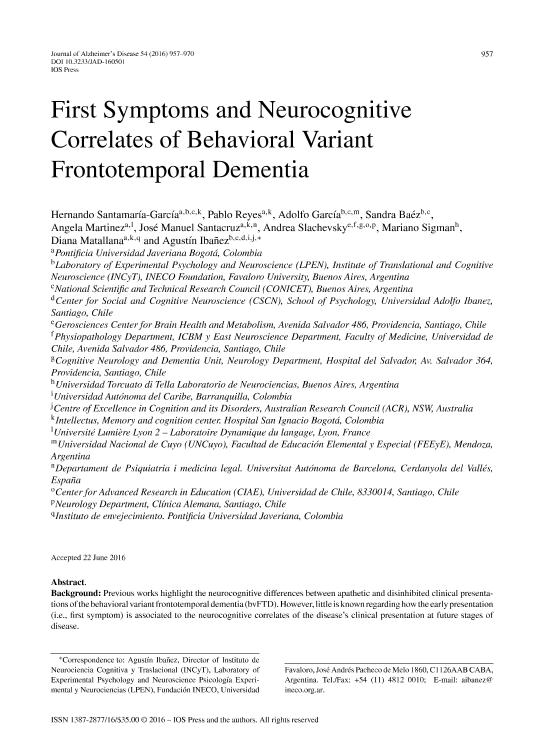Mostrar el registro sencillo del ítem
dc.contributor.author
Santamaria Garcia, Hernando

dc.contributor.author
Reyes, Pablo
dc.contributor.author
García, Adolfo Martín

dc.contributor.author
Báez Buitrago, Sandra Jimena

dc.contributor.author
Martinez, Angela
dc.contributor.author
Santacruz, Jose Manuel
dc.contributor.author
Slachevsky, Andrea
dc.contributor.author
Sigman, Mariano

dc.contributor.author
Matallana, Diana
dc.contributor.author
Ibañez, Agustin Mariano

dc.date.available
2018-03-19T21:07:57Z
dc.date.issued
2016
dc.identifier.citation
Santamaria Garcia, Hernando; Reyes, Pablo; García, Adolfo Martín; Báez Buitrago, Sandra Jimena; Martinez, Angela; et al.; First Symptoms and Neurocognitive Correlates of Behavioral Variant Frontotemporal Dementia; IOS Press; Journal of Alzheimer's Disease; 54; 2016; 957-970
dc.identifier.issn
1387-2877
dc.identifier.uri
http://hdl.handle.net/11336/39288
dc.description.abstract
BACKGROUND:Previous works highlight the neurocognitive differences between apathetic and disinhibited clinical presentations of the behavioral variant frontotemporal dementia (bvFTD). However, little is known regarding how the early presentation (i.e., first symptom) is associated to the neurocognitive correlates of the disease´s clinical presentation at future stages of disease.OBJECTIVES:We analyzed the neurocognitive correlates of patients with bvFTD who debuted with apathy or disinhibition as first symptom of disease.METHODS:We evaluated the neuropsychological, clinical, and neuroanatomical (3T structural images) correlates in a group of healthy controls (n = 30) and two groups of bvFTD patients (presented with apathy [AbvFTD, n = 18] or disinhibition [DbvFTD, n = 16]). To differentiate groups according to first symptoms, we used multivariate analyses.RESULTS:The first symptom in patients described the evolution of the disease. AbvFTD and DbvFTD patients showed increased brain atrophy and increased levels of disinhibition and apathy, respectively. Whole brain analyzes in AbvFTD revealed atrophy in the frontal, insular, and temporal areas. DbvFTD, in turn, presented atrophy in the prefrontal regions, temporoparietal junction, insula, and temporoparietal region. Increased atrophy in DbvFTD patients (compared to AbvFTD) was observed in frontotemporal regions. Multivariate analyses confirmed that a set of brain areas including right orbitofrontal, right dorsolateral prefrontal, and left caudate were enough to distinguish the patients´ subgroups.∥Conclusion: First symptom in bvFTD patients described the neurocognitive impairments after around three years of disease, playing an important role in the early detection, disease tracking, and neuroanatomical specification of bvFTD, as well as in future research on potential disease-modifying treatments.
dc.format
application/pdf
dc.language.iso
eng
dc.publisher
IOS Press

dc.rights
info:eu-repo/semantics/openAccess
dc.rights.uri
https://creativecommons.org/licenses/by-nc-sa/2.5/ar/
dc.subject
Apathy
dc.subject
Behavioral Variant Frontotemporal Dementia
dc.subject
First Symptom
dc.subject
Voxel-Based Morphometry
dc.subject.classification
Inmunología

dc.subject.classification
Medicina Básica

dc.subject.classification
CIENCIAS MÉDICAS Y DE LA SALUD

dc.title
First Symptoms and Neurocognitive Correlates of Behavioral Variant Frontotemporal Dementia
dc.type
info:eu-repo/semantics/article
dc.type
info:ar-repo/semantics/artículo
dc.type
info:eu-repo/semantics/publishedVersion
dc.date.updated
2018-03-12T19:22:08Z
dc.journal.volume
54
dc.journal.pagination
957-970
dc.journal.pais
Países Bajos

dc.journal.ciudad
Amsterdam
dc.description.fil
Fil: Santamaria Garcia, Hernando. Pontificia Universidad Javeriana; Colombia. Consejo Nacional de Investigaciones Científicas y Técnicas. Oficina de Coordinación Administrativa Houssay. Instituto de Neurociencia Cognitiva. Fundación Favaloro. Instituto de Neurociencia Cognitiva; Argentina. Hospital San Ignacio Bogotá; Colombia
dc.description.fil
Fil: Reyes, Pablo. Hospital San Ignacio Bogotá; Colombia. Pontificia Universidad Javeriana; Colombia
dc.description.fil
Fil: García, Adolfo Martín. Consejo Nacional de Investigaciones Científicas y Técnicas. Oficina de Coordinación Administrativa Houssay. Instituto de Neurociencia Cognitiva. Fundación Favaloro. Instituto de Neurociencia Cognitiva; Argentina. Universidad Nacional de Cuyo; Argentina
dc.description.fil
Fil: Báez Buitrago, Sandra Jimena. Consejo Nacional de Investigaciones Científicas y Técnicas. Oficina de Coordinación Administrativa Houssay. Instituto de Neurociencia Cognitiva. Fundación Favaloro. Instituto de Neurociencia Cognitiva; Argentina
dc.description.fil
Fil: Martinez, Angela. Pontificia Universidad Javeriana; Colombia. Universite Lyon 2; Francia
dc.description.fil
Fil: Santacruz, Jose Manuel. Hospital San Ignacio Bogotá; Colombia. Pontificia Universidad Javeriana; Colombia. Universitat Autònoma de Barcelona; España
dc.description.fil
Fil: Slachevsky, Andrea. Gerosciences Center for Brain Health and Metabolism; Chile. Universidad de Chile; Chile. Hospital del Salvador; Chile
dc.description.fil
Fil: Sigman, Mariano. Universidad Torcuato di Tella; Argentina. Consejo Nacional de Investigaciones Científicas y Técnicas; Argentina
dc.description.fil
Fil: Matallana, Diana. Hospital San Ignacio Bogotá; Colombia. Pontificia Universidad Javeriana; Colombia
dc.description.fil
Fil: Ibáñez Barassi, Agustín Mariano. Consejo Nacional de Investigaciones Científicas y Técnicas. Oficina de Coordinación Administrativa Houssay. Instituto de Neurociencia Cognitiva. Fundación Favaloro. Instituto de Neurociencia Cognitiva; Argentina. Universidad Adolfo Ibañez; Chile. Universidad Autónoma del Caribe; Colombia. Australian Research Council; Australia
dc.journal.title
Journal of Alzheimer's Disease

dc.relation.alternativeid
info:eu-repo/semantics/altIdentifier/doi/http://dx.doi.org/ 10.3233/JAD-160501
dc.relation.alternativeid
info:eu-repo/semantics/altIdentifier/url/https://content.iospress.com/articles/journal-of-alzheimers-disease/jad160501
Archivos asociados
